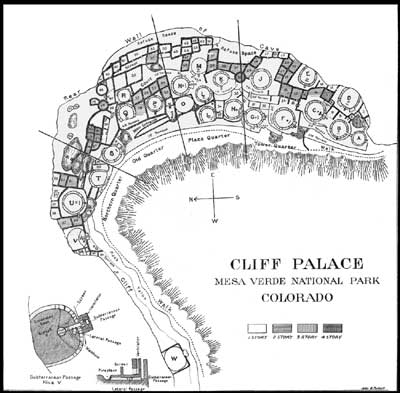Cliff Palace is situated in a cave in Cliff-palace
canyon, a branch of Cliff canyon, which is here about 200 feet deep. It
occupies practically the whole of the cave, the roof of which overhangs
about two projecting considerably beyond its middle. This thirds of the
ruin cave is much more capacious than that in which Spruce-tree House is
situated, as shown by comparing illustrations and descriptions of the
latter in the former report. The configuration of Spruce-tree House cave
and that of Cliff Palace, and the relation of its floor to the talus,
also differ. The canyon in which Cliff Palace lies is thickly wooded,
having many cedars and a few pines and scrub oaks; the almost total
failure of water at certain seasons of the year at Cliff Palace renders
floral life in the vicinity less exuberant than in Spruce-tree canyon, a
branch of Navaho canyon (fig. 1). On the level plateau above the ruin
there are many trees—pines and cedars— but even this area is
not so thickly wooded as the summit of the mesa above Spruce-tree
House.a
aClearings in the forest indicate the
positions of the former farms of the inhabitants of Cliff Palace.

Plate 7. SOUTHERN END, AFTER REPAIRING
(photographed by R. G. Fuller)
|
The geological formation of the cave in which Cliff
Palace is situated is similar to that at Spruce-tree House. consisting
of alternating layers of hard and soft sandstone, shale, and even
layers of coal. Both canyons and caves appear to have been formed by the
same processes. In past ages the elements have eroded and undermined
the soft layers of sandstone or shale to such an extent that great
blocks of rock, being left without foundations, have broken away from
above, falling down the precipice. Many of these great bowlders remained
on the floor of a cave where it was broad enough to retain them. The
surface of the roof arching over Cliff Palace cave is perhaps smoother
than that of Spruce-tree House. The progress of cave erosion was greatly
augmented by the flow of water from the mesa summit during heavy rains,
as hereinafter described.

FIG. 1.—View down Navaho Canyon.
|
To understand the general plain of Cliff Palace it is
necessary to take into consideration the method of formation and the
configuration of the cave floor on which the ruin stands. This cave, as
already stated, was formed by erosion or undercutting the softer rock
at a lower level than the massive sandstone, leaving huge blocks of
stone above the eroded cavities. Naturally these blocks, being without
support, fell, and in falling were broken, the larger fragments remaining
on the floor practically in the places where they fell, but many of
the smaller stones were washed out of the cave entrance, forming a talus
extending down the side of the cliff. The floor of the cave was thus
strewn with stones, large and small, resting on the same general level
which is that on which the foundations of the buildings were
constructed. The level of the cave floor was interrupted by the huge
blocks of stone forming its outer margin; and the buildings constructed
on these fallen rocks were lofty, even imposing. The talus composed of
fallen rock and debris, piled against the canyon side in front of these
buildings and below these huge blocks of stone, extends many feet down
the cliff in a gradual slope, covering the terraced buildings and
burying their retaining walls from sight.a A great part of this
talus is composed of fallen walls, but considerable earth and small
stones are contained in it, probably precipitated over the rim of the
cave roof by the torrents of water which sometimes fall during heavy
rains. It is probable also that the foresting of the talus has been due
more or less to bushes and small trees washed over the cliff from the
mesa summit.
aAccess to Cliff Palace from the bottom of the
canyon, although difficult, is possible, and a pathway might be
constructed down its sides or along the top of the talus to several
other cliff-dwellings. In the vicinity of Cliff Palace there are at
least 20 ruins, large and small.
Three terraces or tiers containing rooms, as shown in
the accompanying ground plan, were revealed by excavations in this
talus. At the western extension, where the second and third terraces
cease, the tops of large rocks begin at the level of the fourth terrace,
and on the southern end the first terrace is absent. At the western
extremity, the large blocks of rock having dropped down entire from the
side of the cliff, fill the interval elsewhere occupied by the lower
terraces, and their tops now form a ledge upon which rest the
foundations of rooms level with the plaza. It is thus evident that
whereas the front wall of Spruce-tree House is simple, the level of the
kiva roofs and floors of buildings above ground being continuous, the
front of Cliff Palace is complicated, being at different levels,
consisting of terraces in the talus. As one approached Cliff Palace, when
inhabited, it must have presented, from below, an imposing structure,
the lower terraces being occupied by many large kivas above which rose
lofty buildings arranged in tiers, several being four stories high.
Although the height was much increased by the presence of huge
foundation blocks of sandstone, from the lowest terrace to the highest
room there were seven floor levels, including those of the kivas in the
terraces.
An examination of Cliff Palace cave shows that from
the southern end to the section over the main entrance its roof arches
upward and that the part over the rear of the ruin is lower than that
over its front. Between the lower and upper roof levels there is a sharp
break formed by a vertical cleavage plane. Where this plane joins the
upper level there is a shelf forming a recess in which has been
constructed a row of ledge rooms.b
bOne of these rooms had been chosen by eagles
for their nests, but both nests and eggs were abandoned by the birds
after the repair work was began.
The great rock roof arching over Cliff Palace is
broken about midway between the vertical plane above mentioned and the
rim by another and narrower vertical plane where no ledge exists. Here
multitudes of swallows had made their home, and there are wasps' nests
in several places.

Plate 8. CLIFF PALACE GROUND PLAN (from survey
by R. G. Fuller) (click on
image for an enlargement in a new window)
|



